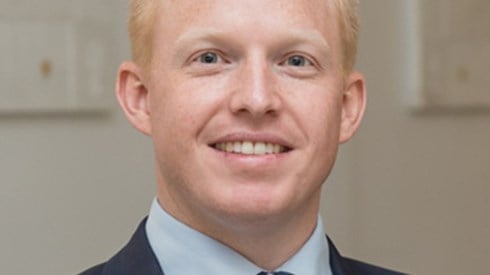Ian Davis Expands His Captive Insurance Skills in New Banking Role

June 09, 2021

Ian Davis is senior vice president, captive insurance relationship manager at People's United Bank in Burlington, Vermont. In that position, he is responsible for business development, qualification, expansion, and overall relationship management of the bank's captive insurance portfolio.
Mr. Davis joined People's United Bank after serving as director of financial services in the Vermont Department of Economic Development, where he led the marketing and business development activities in support of the state's captive insurance industry.
In the interview below, Mr. Davis discusses a wide range of captive insurance issues, including features that make captive domiciles attractive, why captives are taking on more risks, and future captive growth.
For many years, you led the marketing and business development for Vermont's captive industry. What do you think were your most significant accomplishments in that role?
I thoroughly enjoyed my time with the state. It is very much a collaborative atmosphere between the Department of Financial Regulation, Department of Economic Development, and the Vermont Captive Insurance Association (VCIA). Upon reflection, some of the things I am most proud of and that I really focused on during my tenure include an expansion into international markets, specifically Europe and Latin America.
Vermont today is home to a large number of captives whose parents are based in countries outside the United States. Those companies have the ability to domicile their captives anywhere: in the United States, offshore, Europe, or elsewhere. Vermont has been successful attracting a considerable number of international companies with captives because of that focus on international markets, promoting the state as the premier domicile, and having the necessary services and expertise to regulate these complex captive arrangements.
In addition, there remains a real focus on developing the next generation of captive professionals. During my time as director of financial services, that was something I was very intent on doing. Whether it was working closely with colleges and universities in the state, making sure that Vermont played a leading role in supporting industry efforts to develop the next generation of captive professionals, or even getting in front of students to talk about the opportunities that exist in the captive industry—all were very meaningful to me personally and will hopefully have lasting positive impacts on the captive industry.
Why did you decide to leave last year and join People's United Bank?
For me, it presented a unique opportunity to build upon the knowledge and expertise that I had developed in my previous role in the captive industry, while at the same time come at the industry from the different perspective, working more closely with captive clients and their service provider partners. For me, that followed a nice trajectory, allowing me to deepen my skill sets while continuing to work in an industry I care so much about.
People's United Bank, along with its predecessor institutions, has had a long history of working with and servicing the captive industry. Still, People's really did not have a formalized captive practice. This was an opportunity to build on that legacy. In my limited time with the bank, it has been extremely rewarding to work closely with captive owners and their service providers. It represents a new professional challenge and a great opportunity.
What's your role at People's United Bank?
In my role as senior vice president, captive insurance relationship manager, I am responsible for the business development, qualification, expansion, and overall relationship management of the bank's captive insurance portfolio. I lead a dedicated team of captive professionals to help provide and facilitate services that help captive owners operate their captives more efficiently. That ranges from depository and treasury account services to ensuring for captive owners that their captives are operating as efficiently and effectively as they can. I also work very closely with our captive investment partners to support our captive clients that are pursuing investments as part of their overall captive strategy.
How is People's United Bank involved in the captive insurance industry?
One of the things that really appealed to me in taking this position is that People's United is a full-service financial institution that specializes in servicing this industry. We not only serve our captive clients with tailored financial services but also work collaboratively with the management community and the other service providers we interact with to help support captive owners.
During the last few years, captive growth in many domiciles has slowed down significantly. Do you see that changing and, if so, why?
Looking back over the last 3 to 5 years, at first glance it would appear that the number of captives had somewhat plateaued. There were a number of factors that contributed to this diminished growth, including competitive rates available on the commercial marketplace, mature captives winding down, and the pushback against 831(b) captives, the latter of which has been extremely positive, in my view. Those trends have been reversed in dramatic fashion over the past year, and I see the growth continuing for several reasons. Captives are far more mainstream today and no longer are just accessible to the largest and most sophisticated organizations. Increasingly, we are seeing small and midsized companies, either through group or cell captive arrangements, avail themselves of the benefits of captives. That is all very positive for the industry.
There are dozens of domiciles around the United States and around the world. Which domiciles stand out, and what made those domiciles so successful?
While I now consider myself to be domicile agnostic (i.e., People's United Bank serves all major domiciles, both on and offshore), there are common themes that the best domiciles share. Foremost in my mind would be a collaborative regulatory approach to working with captive owners to arrive at solutions that both fit within regulatory guidelines while also allowing innovative approaches to risk management and risk financing.
Having a strong infrastructure of service providers is something that lends itself to domiciles that have been around for a longer period of time and is critically important, allowing for a close working relationship between the service provider community and the regulators.
The last would be having an active and engaged trade association that is an advocate for captives. While there has been a proliferation of trade associations over the years, Vermont continues to have the longest-running and best-known captive association: the VCIA. The VCIA has provided the template for what it means to have an active industry organization that promotes the captive industry, providing professional development and education, legislative advocacy, and networking opportunities for captive professionals.
Are captives taking on new risks?
We have heard for many years about new and emerging risks like cyber, cannabis, and others where the captive industry is in some cases looking to fill a void that exists from a coverage and/or pricing standpoint. My impression is that captive owners are always looking to innovate and find new and creative ways to help support the parent organization. They will take on new risks if it is actuarially sound and makes sense from a regulatory and pricing standpoint. Captives are inherently about taking innovative approaches to risk management. I see that occurring now, both from the clients we serve and in talking with my colleagues in the industry. It is extremely encouraging.
What issues should trade associations and companies consider when deciding whether to set up a captive?
In my mind, it is always important to have risk management at the center of any captive program as opposed to any of the many ancillary benefits of forming a captive. At the end of the day, it has to be a desire to have better risk management practices in one's organization.
Does the captive insurance industry face challenges in the years ahead?
While I won't try and predict the future, I will say that whenever legal or regulatory challenges have presented themselves, I have been highly encouraged by the way in which trade associations such as VCIA, Captive Insurance Companies Association, and National Risk Retention Association have moved into those headwinds and taken a leadership role. By working collaboratively, those groups have found ways to help mitigate and better educate other stakeholders in cases where it is required to protect our industry.
On the other side, what opportunities does the captive industry face in the years ahead?
With the last year as an example, if we look at the prevalence of companies that are really struggling in the commercial insurance marketplace, more and more companies are recognizing that captive insurance is a viable alternative. That is why I am so excited to be part of this industry during this time, because I think that in the coming years we are going to see this continue. At the same time, we have people promoting captives for the right reasons, and we have a myriad of examples of successful captive programs with captive owners that are willing to share their stories. In so doing, that is getting a lot of prospective captive owners and companies to say, "This is something we really should look deeper into."
(Courtesy photo of Mr. Davis, above.)
June 09, 2021
